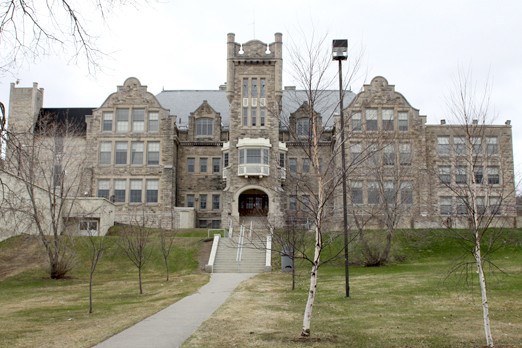THUNDER BAY – A group of students at Lakehead University’s law school hope to help address their profession’s representation problem at the source.
Members of the Black Law Students’ Association (BLSA) of the Bora Laskin Faculty of Law, founded last year, want to open the door for more students of colour to become lawyers.
“We’re trying to make our own little change that will ripple into something greater,” said BLSA president Tochi Nwaokocha.
This year, the group have set their sights on changes to the school’s recruitment and admission practices that they believe could bring more diversity to the classroom.
Around 20 per cent of Ontario lawyers self-identify as racialized, according to the Law Society of Ontario’s most recent statistics. That figure has doubled over the past two decades, but still lags well behind the approximately 30 per cent of Ontarians who are racialized.
The situation is similar for Black Ontarians specifically, who make up 4.2 per cent of the population and less than 3.2 per cent of its lawyers.
The discrepancy grows larger at senior levels, Nwaokocha said. It’s a status quo he and other students with the BLSA hope to play a part in changing.
“Seeing Black people in spaces of authority and of power matters,” he believes. “If I didn’t see someone that I could look up to as a Black lawyer, it would be very difficult for me to see myself in this position I’m in today.”
Greater representation in the profession will ultimately make the legal system as a whole more equitable, the group argues.
“We believe having better access to legal education for Black students will translate into better access to justice for Black and racialized communities,” said BLSA treasurer Sharon Tathgur.
While the COVID-19 pandemic has cut down on some of the association’s activities, the group has continued its advocacy work, particularly on proposed changes to recruitment and admissions.
BLSA leaders praised the school for its openness to having that conversation, after meeting in November with Dean Jula Hughes.
“We’ve been lucky enough for them to actually take the concerns we’ve brought forward [seriously],” said Nwaokocha. “They’re looking at ways to increase representation, they’re looking at strategies to change how they recruit.”
That has included discussions about a new equity and inclusion policy, changing application processes, and plans to feature racialized students more prominently in recruitment materials and activities.
Hughes welcomed the opportunity to work with the group, calling underrepresentation in the profession a longstanding problem.
The school supports a first step the BLSA sees as key: establishing baseline information on the diversity of its applicants. That would require modifying Ontario’s centralized application system – something the province’s law schools are currently discussing.
Hughes was optimistic about buy-in to the change.
“As it currently stands, we simply have no mechanism for identifying Black applicants, racialized applicants from the bigger pool,” she said. “I think it’ll be inherently a good thing to have access to that data, because it’ll allow us to monitor and understand better where our recruitment is effective, and where we have work to do.”
The BLSA hopes changes to the application process will go beyond boxes on a self-identification question, to allow for an additional written section in which racialized students could speak to how their experiences inform their desire to practice law.
Currently, applicants to Bora Laskin must focus on one of the school’s three mandates in their written submission: the environment and natural resources, Indigenous law, and small and rural practice.
Those may not immediately resonate with some racialized students, said Tathgur.
“One of our goals is to try to find some way where people could discuss how they may not feel a connection to [those] mandates” when applying, she said.
Hughes believes there are many actions law schools can take to improve diversity, short of mandating representation.
“The experience with the inclusion of women in the legal system has been that measuring is important, but that we were able to get to good participation of women without imposing quotas, which might improve the acceptability of graduates in the profession,” she said.
And while diversifying the student body would be one indicator of success, she said, inclusion goes far beyond the numbers.
“I would caution against a purely quantitative metric,” she said. “It also matters how students are experiencing law school: what’s their sense of the support they have, is there space for culture, is there space for diversity, is the curriculum appropriate, are we talking and thinking about matters that affect racialized communities in the right way?”
The experiences of racialized people with the law are not always represented in the classroom, said Tathgur.
“I realized it was never really discussed in any of my first year classes,” she reflected. “It was probably briefly touched upon for Indigenous and Aboriginal law… I noticed that for any other cases with a Black or racialized person, it’s not really discussed.”
She hopes the BLSA can work with the school on incorporating those issues into the curriculum.
Raising questions of racism and representation can be intimidating for young lawyers, she added, but she says law firms are increasingly embracing the conversation.
“I feel like they’re more open to that now,” she said. “Hearing that is encouraging for me, to know I shouldn’t be afraid to ask these realistic questions that are going to impact the way I work, or how I see myself fitting into a job.”
As the next generation of legal professionals, it’s a change the students involved with the BLSA feel a responsibility to champion and accelerate.
“Any organization the size of the law society or any government organization, it will take time to get those changes to be visible, so you can actually see and feel them,” said VP Patrick Palmer. “I hope I will be able to be part of that change when I enter the law profession.”



